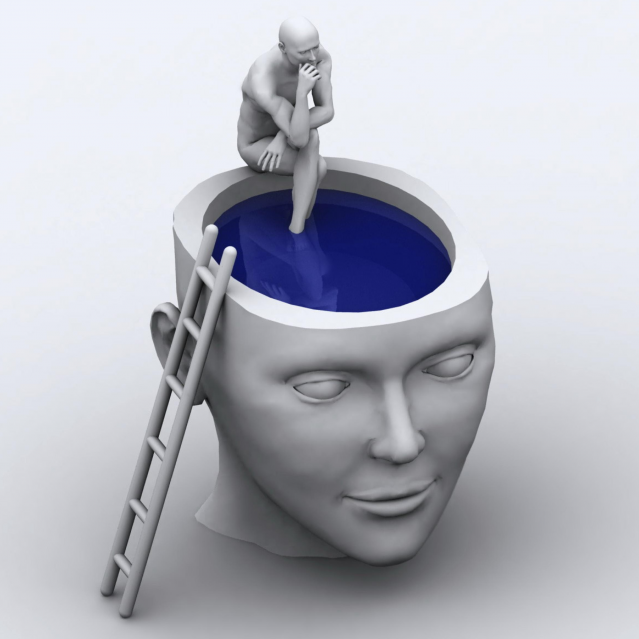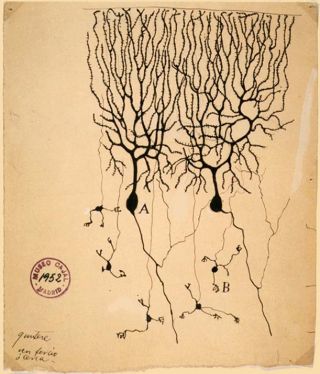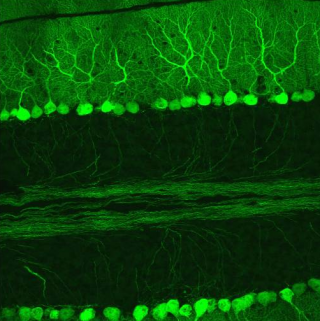Cognition
The Neuroscience of Knowing Without Knowing
Metacognition and the importance of thinking about your thinking
Posted November 17, 2014

Metacognition is the ability to think about your thinking. Our unique prefrontal cortex allows humans to scientifically study and begin to understand the workings of our unconscious minds. But how does our unconscious mind communicate with our conscious mind without our prefrontal cortex being cognitive of this interaction?
Recently, neuroscientists have made fascinating discoveries about how specific brain neurons (Purkinje cells) housed in the cerebellum allow your unconscious mind to store implicit learning and memory traces without any involvement of the cerebral aspects of the prefrontal cortex.
Purkinje cells are named after Johannes Purkinje, who first identified these neurons in 1837. Dr. Purkinje was also the first person to identify the individuality of the human fingerprint. He had a knack for discovering relatively obvious things that everyone else had overlooked.
Purkinje cells are the most distinctive neurons in the brain. Although you only have 15-25 million Purkinje cells (a relatively small number) each Purkinje cell makes synaptic connections to over 200,000 other neurons, which is a relatively huge number. The dendrites of a Purkinje cell look like a Chinese fan and are arranged at right angles to the parallel fibers that makes millions of connections but only have one axon that communicates all of this consolidated input.
Beyond Muscle Memory: Are Purkinje Cells and the Cerebellum the Seat of Our Unconscious Mind?
In an October 2014 study, "Spectral Signatures of Reorganised Brain Networks in Disorders of Consciousness," researchers at the University of Cambridge found 'hidden brain signatures' of consciousness in patients who were in a vegetative state.
The neuroscientists in Cambridge discovered the hidden signatures and memory traces in the brains of people in a persistent vegetative state by asking them to imagine playing tennis. In a select number of patients who appeared unconscious, the brain networks associated with playing tennis lit up in the fMRI when they were asked to imagine playing tennis.
This revolutionary finding implies that even when a patient appeared to be unconscious and unresponsive, a part of the brain was able to take in the information and show through an fMRI that memory traces were still intact.
Although this study did not identify the specific brain regions that held these memory traces, an educated guess would imply that the Purkinje neurons of the cerebellum are involved.

Purkinje cells by Ramon y Cajal
As a young tennis player, my father—who was a neuroscientist, neurosurgeon, and author of The Fabric of Mind (Viking)—was my coach. As a scientist, my father was a visionary and iconoclast who was obsessed with Purkinje cells and the cerebellum. In the 1970s, most of his colleagues at Harvard Medical School considered him a heretic when he spoke about his belief that the cerebellum played a role in cognitive processes.
When I was growing up, my dad would coach me at tennis saying, "Think about hammering and forging the muscle memory into the Purkinje cells of your cerebellum with every stroke."
My dad was also cognizant that overthinking in tennis could cause you to choke. Tennis legend Arthur Ashe summed up the need for tennis players to be more cerebellar (of or pertaining to the cerebellum) than cerebral with his famous description of "paralysis by analysis." The key to succeeding in most sports is to "unclamp" the executive function of the prefrontal cortex and allow the cerebellum to run the show.

I first learned about the power of the cerebellum as a young tennis player, but relied on my understanding of the cerebellum to train and compete as an ultra-endurance runner. As a native New Yorker, I did most of my training for ultra-endurance sports inside a gymnasium on stationary equipment. I turned myself into a human lab rat on the treadmill and had lengthy discussions with my father about the neuroscience behind my athletic experiences.
Running non-stop on a treadmill for 24 hours opened up a primordial state of consciousness in which time and cognitive function became surreal and the doors of my perception were dramatically altered.
I have no conscious memory of running the last marathon when I broke the Guinness World Record by running 153.76 miles on a treadmill in 24 hours. I ran the final hours of the treadmill event in a vegetative state. It was mystifying to wake up in the ICU at the Beth Israel Hospital with no real recollection of how I completed the athletic feat.
Although I had always been fascinated by the cerebellum, this experience gave me a first hand understanding of how important the Purkinje cells and the cerebellum are in sport and life.
I firmly believe that I was able to run a marathon on a treadmill in a vegetative state due to years of conditioning embedded in the Purkinje cells of my cerebellum. This is why I put the cerebellum in the spotlight throughout The Athlete's Way (St. Martin's Press) in 2007 and remain committed to making "cerebellar" a household word.

Cerebellum in red.
Two different studies from September 2014 found that the Purkinje neurons in the cerebellum respond instantaneously to a conditioned stimulus before the conscious mind has time to process either the stimuli or the response. This is potentially another revolutionary discovery about the power of Purkinje cells and the cerebellum.
The first September 2014 study, “Memory Trace and Timing Mechanism Localized to Cerebellar Purkinje Cells” was published in the journal Proceedings of the National Academy of Sciences.

Purkinje cells in green
The researchers discovered that Purkinje cells can learn to respond to paired stimuli within hundredths of a millisecond without any input from the cerebrum. The researchers believe that this finding radically changes current views of both neural signaling and learning.
In studying how cerebellar Purkinje cells change their responsiveness to a stimulus during learning of conditioned responses, the researchers at Lund University in Sweden found that individual Purkinje cells can learn highly specific timing relationships between two paired stimuli without cerebral input.
Previous research has challenged traditional concepts of the cerebellum's role in cognitive function by showing that through its connections with the prefrontal cortex, the cerebellum contributes to both the planning and execution of the movement, and is involved in higher cognitive functions.

Purkinje cell in green.
The Swedish researchers studied animals that learned to associate a sound with a puff of air in the eye that caused them to blink. If the time between the sound and the puff of air was a quarter of a second, the animals blinked after a quarter of a second even if the puff of air was removed. If the time was changed to half a second, the animals blinked exactly a half second later.
Until now, neuroscientists have assumed that this timing mechanism is a result of strengthening or weakening of synaptic connections throughout a network of nerve cells. However, in this breakthrough discovery, the scientists at Lund University have shown that no networks are necessary. A single Purkinje cell can learn when it is time to react to an air puff. The unconscious learning and memory trace appears to be intrinsic to the Purkinje cell itself.
While the researchers in Sweden are continuing to study which specific transmitter substance and what receptor on the surface of the Purkinje cell are responsible for the newly discovered timing mechanism, scientists at the University of Pennsylvania and Princeton are conducting similar research.
In a second September 2014 study, “Coding of Stimulus Strength Via Analog Calcium Signals in Purkinje Cell Dendrites of Awake Mice,” the US researchers found that Purkinje cells in the cerebellum can detect errors caused by unexpected sensory events within milliseconds of the stimuli.
This study was led by Javier Medina, an assistant professor in the Department of Psychology in Penn's School of Arts & Sciences, and Farzaneh Najafi, who was a graduate student in the Department of Biology. They collaborated with postdoctoral fellow Andrea Giovannucci and associate professor Samuel S. H. Wang of Princeton University.
"Though there is a large population of climbing fibers that can give error-related information to the relevant Purkinje cells when they encounter something unexpected, not all of them fire each time," Medina said in a press release. "We saw that there is information coded in the number of climbing fibers that fire. The longer puffs corresponded to more climbing fibers sending signals to their Purkinje cells."
The researchers point out that this type of error detection is what hard wires muscle memory and allows your brain to learn unconsciously from mistakes, which is critical for improving fine motor control and learning through practice.
Interestingly, Sam Wang at Princeton (who was also involved in the Medina study) has found a strong link between the cerebellum and autism. In another September 2014 study he and his colleagues found that humans rely on the cerebellum for making unconscious conditioned associations and implicit memory markers to understand social cues like a smiling face.
In children with autism, Wang believes that damage or malfunction of the cerebellum at a vulnerable stage of development hinders the cerebellum from being able to learn these implicit social cues during childhood development.
Purkinje Cells Are Uniquely Beautiful and Exponentially Powerful

Neuroscientists have long believed that learning and memory relies on the strengthening or weakening synaptic connections through neuroplasticity and neural pruning. What makes the latest research so exciting is the affirmation that the memory trace of an individual Purkinje cell mechanism can create memory traces that are intrinsic to a single Purkinje cell.
Individual Purkinje cells can learn to respond to changes in unconscious conditioned repsonses and adapt to finely tuned patterns of timing. Purkinje cells appear to be able to "know" without "knowing" and operate automatically and appropriately to a specific stimuli within milliseconds.
On page 119 of The Athlete's Way I describe the unique structure of the Purkinje cells as I learned it from my father:
The syanptic plasticity of Purkinje cells is in your hands. They are reshaped daily through practice and repetition. The Purkinje cells work at a quantum speed. The amplification of more than two hundred thousand incoming signals through one axon offers parallel processing capability from the cerebellum to the cerebrum ... The final output of any given Purkinje cell is via a single axon but all the Purkinje cells are working autonomously, but simultaneously. They oscillate together and march in lock step. These cells take sensory information from all parts of the body and send it to the cerebrum.

Conclusion: Do You Need a Hippocampus to Store Implicit Memories?
HM, the famous brain patient who had his entire hippocampus removed in a botched attempt to treat epilepsy, suffered complete amnesia and could not form any declarative memories. However, with a cerebellum in tact he was able to learn how to solve puzzles and retain cerebellar procedural memories that he had no cerebral recognition of learning.
These new findings on the power of individual Purkinje cells to hold memory traces offer new clues on how memory and learning can take place without the hippocampus, which is traditionally believed to be the seat of learning and memory.
The Merriam-Webster dictionary defines Knowledge as: " information, understanding, or skill that you get from experience or education." In terms of metacognition, it's important to divide the type of declarative knowledge that you learn through education and the type of implicit knowledge you gain through experience, or practice.
For too long, the emphasis has been solely on the prefrontal cortex and cerebrum as the seat of all knowledge. These new findings add credence to my belief that the Purkinje cells of the cerebellum play an important role in optimal cognitive function which combines declarative and implicit learning and memory.
All of this research is revolutionary and has exciting future applications. Having a better understanding of Purkinje cells and the cerebellum could lead to faster rehabilitation following traumatic brain injury or a stroke. These finding could also help treat conditions such as autism, ADHD and language problems, in which the cerebellum is thought to be a key player.
In terms of your own metacognition, I would highly recommend creating daily habits that continually flex both hemispheres of your cerebrum and both hemipheres of your cerebellum. I believe that the key to creating a lifespan of personal bests and optimizing your brain's full potential lies in activities that bulk up the gray matter and improve white matter connectivity between all four brain hemispheres.
If you'd like to read more on the cerebellum, Purkinje cells, and implicit learning check out my Psychology Today blog posts:
- "Is Cerebellum Size Linked to Human Intelligence?"
- "Primitive Brain Area Linked to Human Intelligence"
- "New Clues On the Inner Workings of the Unconscious Mind"
- "The Mysterious Neuroscience of Learning Automatic Skills"
- "Too Much Chrystalized Thinking Lowers Fluid Intelligence"
- "Why Does Overthinking Cause Athletes to Choke?"
- "Toward a New Split-Brain Model: Up Brain-Down Brain"
- "Neuroscientists Discover How Practice Makes Perfect"
- "How Is the Cerebellum Linked to Autism Spectrum Disorders?"
- “Childhood Family Problems Can Stunt Brain Development”
- "The Neuroscience of Calming a Baby"
- “Why Is Dancing So Good For Your Brain?”
- “The Neuroscience of Madonna’s Enduring Success”
- "Gesturing Engages All Four Brain Hemispheres"
- "The Neuroscience of Superfluidity"
- "One More Reason to Unplug Your Television"
- "Better Motor Skills Linked to Higher Academic Scores"
- "Hand-Eye Coordination Improves Cognitive and Social Skills"
- "The Neuroscience of Imagination"
- "Can Practice Alone Create Mastery?"
- "No. 1 Reason Practice Makes Perfect"
Follow me on Twitter @ckbergland for updates on The Athlete’s Way blog posts.
Photo Credits:
http://freefunny-images.blogspot.com/2014/03/hd-wallpaper-for-3d-carton.html
Thomas Deerinck/ Tumblr
Christopher Bergland home photo.
Wikimedia Commons




